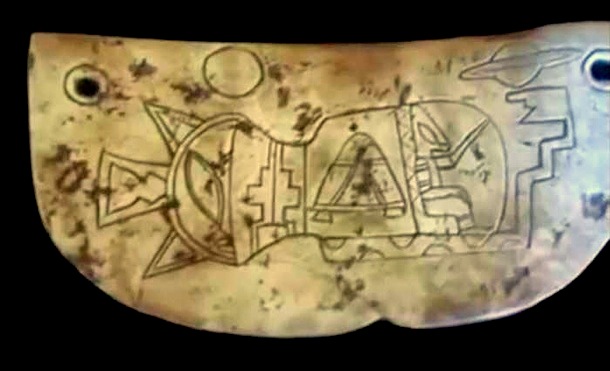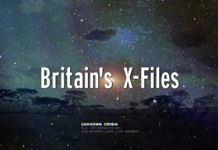Some say alien life forms have visited Earth throughout history. However, such claims are difficult to prove. Most UFO sightings and abductions are easy to dismiss as hoaxes or simple misunderstandings.
But what about the times when the little green men actually leave something behind? Or the artifacts people from ancient times have constructed to honor what could only be visitors from other planets? There are many strange objects in the world, both enigmatic and man-made, that are said to be proof of alien life.
10. The Russian UFO Tooth Wheel

A Russian man found a strange piece of machinery from Vladivostok, the administrative capital of the Primorsky Krai area. The object resembled a piece of tooth wheel and was embedded in a piece of coal he was using to light a fire. Although discarded pieces of old machines are not uncommon in Russia, the man became curious and showed his find to some scientists. Testing revealed that the toothed object was almost pure aluminum and almost certainly artificially made.
Also, it was 300 million years old. This raised some interesting questions, as aluminum of this purity and shape can’t form naturally and humans didn’t figure out how to make it until 1825. Curiously, the object also resembles parts that are used in microscopes and other delicate technical devices.
Although conspiracy theorists have been quick to declare the find a part of an alien spaceship, the scientists researching it are not willing to jump to conclusions and wish to run further tests in order to learn more about the mysterious artifact.
9. The Guatemala Stone Head

In the 1930s, explorers found an enormous, eloquently made sandstone statue in the middle of a Guatemalan jungle. The face carved in the stone didn’t resemble the facial features of the Maya or any of the other people known to have populated the lands. In fact, its elongated cranium and fine features didn’t seem to belong in the history books at all.
Researchers have claimed that the statue’s unique features depict a member of an ancient alien civilization that was far more advanced than any of the pre-Hispanic races of America we know about. Some even speculated the head might just be a part of a much larger construct underneath (this was found to be untrue). Of course, there’s a chance that the statue might be the work of a more recent artist or even a complete hoax. Sadly, we will probably never find out for sure: The head was used for target practice by revolutionary troops and its features have been destroyed to near obscurity.
8. The Williams Enigmalith

In 1998, a hiker named John J. Williams noticed a strange metallic protrusion in the dirt. He dug up a strange-looking rock which, upon cleaning, turned out to have a weird electrical component attached to it. The electric device was clearly man-made and somewhat resembled an electrical plug.
The rock has since become a well-known mystery in UFO enthusiast circles. It has featured in UFO Magazine and (according to Williams) Fortean Times, a famed magazine devoted to mysterious phenomena. Williams, an electrical engineer, says the electronic component embedded in the stone has not been glued or welded into the granite. In fact, the rock probably formed around the device.
Many believe that the so-called Williams Enigmalith is a hoax, as Williams refuses to break it (but is willing to sell it for $500,000). Also, the stone device does bear a certain resemblance to heat rocks that are commonly used to keep tropical pet lizards warm. Still, geological analysis has apparently determined that the stone is around 100,000 years old, which (if true) would mean the device inside can’t possibly be of human creation. Williams is confident enough to let anyone research the Enigmalith on three conditions: He must be present, the rock must remain unharmed, and he will not have to pay for the research.
7. Ancient Aeroplanes

Incas and other pre-Columbian people left behind some extremely puzzling trinkets. Some of the strangest are probably the so-called Ancient Aeroplanes, which are small, golden figures that closely resemble modern jet planes. Originally thought to be zoomorphic (meant to resemble animals), the statues were soon found to have features that look very much like fighter planes’ wings, stabilizing tails, and even landing gears. They were aerodynamic enough that when ancient astronaut believers (allegedly) made model planes with their proportions and fitted them with propellers and (again, allegedly) jet engines, they flew perfectly. All of this has led to speculation that the Incas may have been in contact with (likely extraterrestrial) people who were able to build advanced jet planes, and who perhaps even possessed the technology themselves.
Well, that, or these wonderful statuettes might just be artistic representations of bees, flying fish, or other winged creatures. As always, the beauty is in the eye of the beholder.
6. The Ubaid Lizard Men

Al Ubaid archeological site in Iraq is a gold mine for archeologists and historians. It has yielded numerous objects from a pre-Sumerian time called the Ubaid period (5900–4000 B.C.). However, some of these objects are quite disturbing. A number of Ubaid statues depict strange, lizard-like humanoid figures in unique, unceremonious poses that seem to indicate they were not gods (such as the animal-headed deities of Egypt), but rather a race of lizard people.
Of course, the statues have been drawn into stories and theories of reptilian aliens that used to roam the earth (and perhaps still do, according to conspiracy theorists). Although this seems unlikely, their true nature remains a mystery.
5. The Sri Lanka Meteorite Fossils

Researchers who analyzed the remains of a meteorite that fell in Sri Lanka found that their subject was something more than just pieces of space rock. It was an alien artifact in the most literal sense: an artifact made of actual aliens. Two separate studies have found that the meteorite contains fossils and algae that are clearly of extraterrestrial origin.
Professor Chandra Wickramasinghe, the leading researcher on the first study, says the fossils provide compelling evidence of panspermia (the hypothesis that life exists throughout the Universe and is spread by meteorites and other solid space debris). However, he is not without hiscritics. Wickramasinghe just happens to be a noted panspermia enthusiast with a tendency to claim that almost everything is of extraterrestrial origin. What’s more, the traces of life the meteorite contains are actually freshwater species commonly found on Earth, which seems to indicate the object has been contaminated during its time on our planet.
4. The Summer’s Triumph Tapestry

The tapestry known as Summer’s Triumph was created in Bruges (the capital of West Flanders province in the Flemish Region of Belgium) around 1538. Currently, it resides in the Bayerisches National Museum.
Summer’s Triumph is famous (or infamous) among conspiracy theorists because it clearly depicts a number of distinctly UFO-like objects flying in the skies. Although their presence is baffling, some speculate they may have been added in the tapestry (which depicts a victorious ruler’s ascension to power) in order to connect the UFOs to the ruler as a symbol of divine intervention. This, of course, raises more questions than answers, such as: Why would the 16th-century Belgians recognize flying saucers and mentally connect them with divinity?
3. The Glorification Of The Eucharist

An Italian painter named Ventura Salimbeni is responsible for one of the most mysterious altar paintings in history. “Disputa of the Eucharist,” a 16th-century painting also known as “The Glorification of the Eucharist” (Eucharist is an alternate term for the Holy Communion), is a three-part work. The bottom two parts are relatively normal: They depict a number of religious authorities and an altar. However, the top part shows the Holy Trinity (Father, Son, and a dove depicting the Holy Ghost) looking upon them . . . and holding what seems to be a space satellite. The object is large and spherical, with a metallic finish, telescopic antennas, and strange lights. In fact, it heavily resembles an old Sputnik satellite.
Although UFO enthusiasts and ancient astronaut theorists have often claimed the Disputa as proof of extraterrestrial life (or perhaps time travel), experts have been quick to debunk such notions. According to them, the orb is a Sphaera Mundi, a globe-like representation of the universe that used to be common in religious art. The strange lights on the “satellite” are merely the sun and the moon, and its antennas are actually scepter wands that act as symbols of authority for the Father and the Son
2. The Mexican Government’s Maya Artifacts

The story goes like this: In 2012, the Mexican government released a number of Maya artifacts they had been protecting for 80 years as state secrets. These objects were retrieved from an unexplored pyramid that was found under another pyramid in Calakmul, the site of one of the most powerful ancient Maya cities. A government-sanctioned documentary by Raul Julia-Levy (the son of famous actor Raul Julia) and financier Elisabeth Thieriot (ex-wife of a former publisher of the San Francisco Chronicle) featured a number of these finds, most of which clearly depict UFOs and alien visitors.
The case may seem fairly enticing, but once you look closer, a strange pattern of fraud begins to emerge. Both of the documentarians seem to be lying about something. Julia-Levy doesn’t appear to be who he claims to be—Raul Julia’s widow has publicly called out a con man named Salvador Alba Fuentes. According to her, Salvador is attempting to ride on her late husband’s fame and is going around telling everyone his name is, yes, Raul Julia-Levy. Meanwhile, Thieriot has shut down the production of the documentary and sued her partner, accusing “Julia-Levy” of stealing her documentary and misusing filming equipment (a statement “Julia-Levy” vehemently opposes). What’s more, there seems to be very little scientific proof of the authenticity of the artifacts, and the pictures that have emerged online are less than concrete evidence.
Perhaps the artifacts were cheap fakes manufactured by a local artisan. Perhaps the officials had second thoughts about the documentary and ordered Thieriot to shut it down by any means necessary. Whatever the truth behind these strange artifacts is, their case is far from convincing.
1. The Betz Mystery Sphere

When the Betz family was examining the damage of a strange fire that had decimated 88 acres of their woodland, they made a strange discovery: a silvery sphere, about 20 centimeters (eight inches) in diameter, completely smooth except for a strange, elongated triangle symbol. Initially thinking it might be a NASA gadget or even a Soviet spy satellite, they eventually decided it was most likely just a souvenir. On a moment’s whim, they decided to take it with them.
Two weeks later, the family’s son was strumming a guitar in the same room as the sphere. Suddenly, the sphere started reacting to his tunes, emitting a strange throbbing sound and a resonance that deeply disturbed the family’s dog. Soon, the Betz family found the orb had other strange properties. It could stop and change directions when pushed across the floor, eventually returning to the person who pushed it like a faithful dog. It seemed to draw power from solar energy, becoming noticeably more active on bright days.
It started looking like something (or someone) was controlling the sphere: It would occasionally emit low-frequency rattling and vibrations, like there was a motor running inside. It seemed to avoid falling and crashing at all costs, as if to protect something inside it. It even managed to completely defy the laws of gravity and climb up a slanted table to avoid falling.
A media frenzy ensued. Respected papers such as the New York Times and the London Daily sent reporters to witness the miracle sphere, which repeated its tricks to countless people. Even scientists and representatives of the military were impressed, although the Betz family wouldn’t let them take the sphere for closer examination. However, that soon changed as the sphere took a turn for the worse. It started exhibiting poltergeist–like behavior: Doors started slamming shut at night and strange organ music would fill the house out of the blue. At that point, the family decided to find out what the sphere really was. The Navy analyzed it and found it was . . . a perfectly ordinary (if high-quality) stainless steel ball.
To this day, it’s not entirely clear what the mysterious alien sphere is. However, there have been many theories attempting to explain its possible nature. The most plausible of these is, incidentally, the most mundane: Three years before the Betz family found the orb, an artist named James Durling-Jones was driving in the area where it was found. On the luggage rack on his car roof were a number of stainless steel balls meant for a sculpture he was making, some of which dropped off during the bumpy ride. These balls matched the exact description of the Betz sphere, and were balanced enough to roll around at the slightest provocation (the Betz family lived in an old house with uneven floors, so such a ball would appear to behave erratically). These balls could even emit a rattling sound, thanks to tiny metal shavings stuck inside during the manufacturing process.
Although this doesn’t explain all of the reported phenomena, it certainly casts a shadow over all the “mysterious ghost ball from outer space” rhetorically.














